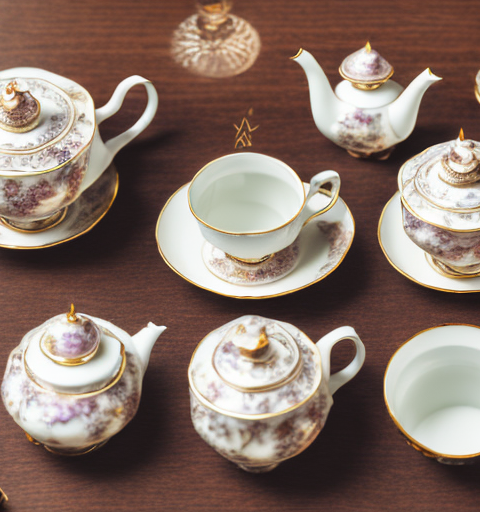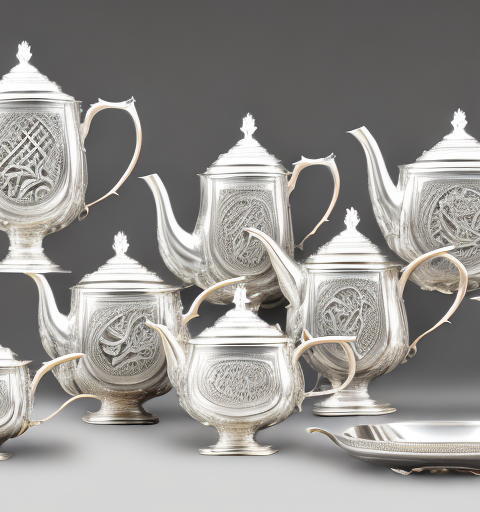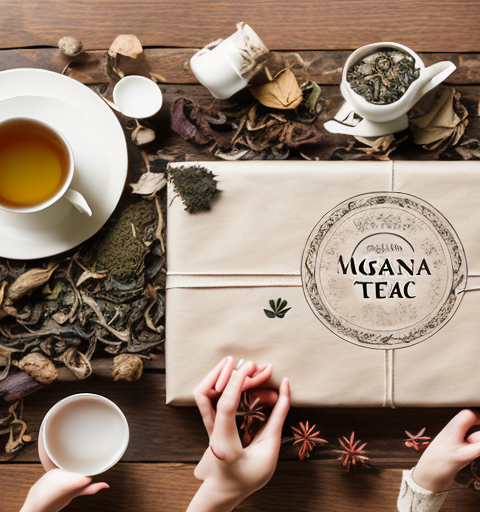Properly storing your ceramic teapot when it’s not in use is essential for maintaining its overall quality and prolonging its longevity. The way you store your teapot can have a significant impact on its condition, ensuring that it stays in perfect shape and is always ready for your next tea session. In this article, we will explore the importance of proper storage for your ceramic teapot and provide you with comprehensive guidelines to help you make the right choices.
The importance of proper storage for your ceramic teapot
Your ceramic teapot is not just a functional vessel for brewing tea; it is also a piece of art and craftsmanship that deserves care and attention. Improper storage can lead to various issues, including damage, discoloration, and deterioration of the teapot’s appearance and functionality. By storing your teapot correctly, you can protect it from potential risks and ensure that it remains a cherished item for years to come.
One important aspect of proper storage for your ceramic teapot is to avoid exposing it to extreme temperatures. Rapid changes in temperature can cause the teapot to expand or contract, leading to cracks or breakage. It is best to store your teapot in a cool, dry place away from direct sunlight and sources of heat, such as stovetops or radiators.
Understanding the potential risks of improper teapot storage
Improper teapot storage can potentially expose your ceramic teapot to risks such as breakage, fading colors, and the accumulation of dust and dirt. When a teapot is not stored correctly, it is more susceptible to accidental bumps or falls, which can lead to irreparable damage. Additionally, exposure to sunlight, extreme temperatures, and high humidity levels can cause the colors of your teapot to fade and the materials to weaken. Dust and dirt can also accumulate on the surface of the teapot, making it less appealing and affecting the taste of your tea.
Another risk of improper teapot storage is the potential for mold and mildew growth. If a teapot is stored in a damp or humid environment, it creates the perfect conditions for mold and mildew to thrive. Not only can this affect the appearance and smell of your teapot, but it can also pose health risks if ingested.
In addition, improper storage can lead to the loss of small parts or accessories that come with your teapot. For example, if the lid or handle is not securely stored, they may become misplaced or damaged over time. This can be frustrating and may require you to find replacements or compromise the functionality of your teapot.
Choosing the right location for storing your ceramic teapot
The location where you store your ceramic teapot plays a crucial role in maintaining its condition. Ideally, you should choose a place that is cool, dry, and away from direct sunlight. Heat and excessive sunlight can cause the teapot to warp, fade, or crack. Avoid placing it near windows or on open shelves where it could be easily knocked over. Instead, opt for a secure and stable location, perhaps in a dedicated teapot cabinet or cupboard, where it will be protected from potential accidents.
In addition to considering the environmental factors, it is also important to think about the proximity to other objects or materials that could potentially damage the ceramic teapot. Avoid storing it near sharp or abrasive objects that could scratch or chip the surface. Additionally, be mindful of any chemicals or cleaning agents that may be stored nearby, as they could potentially react with the ceramic material.
Furthermore, it is recommended to store your ceramic teapot in a place with consistent temperature and humidity levels. Extreme fluctuations in temperature or humidity can cause the teapot to expand and contract, leading to potential damage over time. Consider using a hygrometer to monitor the humidity levels in the storage area and make adjustments as necessary to maintain a stable environment for your teapot.
The benefits of using a dedicated teapot storage solution
Investing in a dedicated teapot storage solution can have numerous benefits for your ceramic teapot. Specialized teapot storage solutions, such as padded or lined cases, can provide an extra layer of protection against accidental bumps and falls. These cases often come with adjustable compartments or dividers, allowing you to safely store multiple teapots or tea sets in one place. Additionally, these storage solutions are usually designed to regulate temperature and humidity levels, helping to maintain an optimal environment for your teapot.
Another benefit of using a dedicated teapot storage solution is that it can help organize your teapot collection. With designated compartments or dividers, you can easily categorize and arrange your teapots based on size, style, or any other criteria you prefer. This not only makes it convenient to find a specific teapot when you need it, but it also adds a touch of elegance to your storage space.
In addition, some teapot storage solutions come with built-in locks or security features. This ensures that your valuable teapots are kept safe and secure, especially if you have a collection of rare or antique teapots. With these added security measures, you can have peace of mind knowing that your teapots are protected from theft or unauthorized handling.
Tips for cleaning and preparing your teapot before storage
Before you store your ceramic teapot, it is crucial to clean and prepare it properly. Start by rinsing the teapot with warm water to remove any tea residue or stains. Avoid using harsh detergents or abrasive scrubbers, as they can damage the teapot’s delicate surface. Instead, use a soft sponge or cloth and mild dish soap to gently clean the teapot. Once cleaned, ensure that the teapot is completely dry before storing it, as moisture can promote the growth of mold or bacteria.
Additionally, it is recommended to remove any removable parts of the teapot, such as the lid or infuser, and clean them separately. This will ensure that all areas of the teapot are thoroughly cleaned and prevent any lingering residue or odors.
Furthermore, if your teapot has stubborn stains or discoloration, you can try using a mixture of baking soda and water to create a paste. Apply the paste to the stained areas and gently scrub with a soft sponge or cloth. This natural cleaning method can help remove tough stains without causing any damage to the teapot’s surface.
How to protect your ceramic teapot from dust and dirt while in storage
To protect your ceramic teapot from dust and dirt while in storage, it is advisable to cover it. You can use a clean, breathable fabric such as cotton or linen to create a protective barrier around the teapot. Avoid using plastic or non-breathable materials, as they can trap moisture and potentially damage the teapot. If you are using a dedicated teapot storage solution, check if it comes with a cover or use a soft cloth to cover the teapot and prevent dust buildup.
The role of temperature and humidity in teapot storage
Temperature and humidity levels are crucial factors to consider when storing your ceramic teapot. Extreme temperatures, whether hot or cold, can cause the teapot to expand or contract, leading to potential cracks or damage. Similarly, high humidity levels can cause moisture to accumulate, which may result in mold growth and deterioration of the teapot’s condition. Therefore, it is best to store your teapot in a cool and dry environment, away from areas with fluctuating temperature and humidity.
Avoiding direct sunlight: Why it’s crucial for teapot longevity
Direct sunlight can have adverse effects on your ceramic teapot’s longevity. Prolonged exposure to sunlight can cause the colors of the teapot to fade and the materials to weaken over time. Additionally, sunlight can generate excessive heat, which may lead to warping or cracking of the teapot. To protect your teapot, store it in a location that is away from direct sunlight, such as a shaded shelf or a teapot cabinet with opaque doors or curtains.
The impact of air circulation on the condition of your ceramic teapot
Adequate air circulation is vital for maintaining the condition of your ceramic teapot during storage. Poor airflow can create a damp environment, leading to the growth of mold or mildew. To ensure proper airflow, avoid tightly sealing the teapot in non-breathable containers or bags. Instead, opt for open storage solutions or use breathable fabric covers that allow air to circulate around the teapot.
Storing a ceramic teapot with delicate decorations or hand-painted designs
If your ceramic teapot features delicate decorations or hand-painted designs, taking extra precautions when storing it is essential. These intricate details can be easily damaged or scratched if not handled properly. Consider wrapping the teapot in acid-free tissue paper or soft cloth before storing it to protect the delicate decorations. Additionally, ensure that there is enough space between the teapot and other items in storage to prevent accidental friction or contact that could potentially damage the designs.
Preventing damage: Best practices for handling and moving your teapot during storage
When handling and moving your teapot during storage, it is crucial to exercise caution to prevent accidental damage. Always hold the teapot with both hands, providing support from the bottom and the handle. Avoid gripping the teapot too tightly or applying excessive pressure, as this can lead to cracks or breakage. If you need to transport the teapot to a different location, use padded or lined containers to ensure its safety and stability during the move.
The pros and cons of storing a ceramic teapot with other kitchenware items
Storing a ceramic teapot with other kitchenware items can have its pros and cons. On one hand, storing your teapot alongside other kitchenware can be a convenient solution, allowing you to keep all your tea-related items in one place. However, it is essential to consider the materials and potential interactions between different kitchenware items. Some materials, such as metal or hard plastic, can scratch or damage the teapot’s surface. If you choose to store your teapot with other kitchenware, ensure that they are clean, dry, and won’t cause any harm or abrasion to the teapot.
Long-term vs. short-term storage options for your ceramic teapot
When deciding on the duration of storage for your ceramic teapot, it is essential to consider whether you are planning for long-term or short-term storage. Long-term storage requires more precautionary measures to ensure that the teapot remains in optimal condition for an extended period. Short-term storage, on the other hand, may be less demanding in terms of protective measures but still requires proper cleaning and safekeeping to prevent any accidental damage.
How to properly wrap and cushion your teapot to prevent breakage during storage
Properly wrapping and cushioning your teapot is crucial for preventing breakage during storage. Start by placing a layer of soft padding, such as bubble wrap or foam, at the bottom of your storage container or shelf. This will create a cushioned surface to protect the teapot from accidental impacts or vibrations. Next, wrap the teapot carefully in acid-free tissue paper or soft cloth, ensuring that all exposed surfaces are adequately covered. Place the wrapped teapot in the container or on the shelf, making sure it is secured and won’t move around during storage.
The benefits of using airtight containers or bags for storing your ceramic teapot
Using airtight containers or bags for storing your teapot can provide additional protection against dust, moisture, and fluctuations in temperature and humidity. Airtight containers or bags can create a controlled environment for your teapot, reducing the risk of exposure to moisture, which can lead to mold growth or damage. However, it is crucial to ensure that the teapot is fully dry before sealing it in an airtight container to prevent moisture from being trapped inside.
Tips for organizing and labeling your tea collection alongside your teapot in storage
If you have a tea collection that accompanies your ceramic teapot, organizing and labeling can make it easier to retrieve specific teas when needed. Consider using storage containers with dividers or compartments to keep different types of teas separate. Place labels or tags on the containers to identify each tea variety, ensuring that you can easily locate a specific tea without having to search through the entire collection. Additionally, make sure that the tea collection is stored away from the teapot to avoid any potential odor transfer.
How to revive a stored ceramic teapot after an extended period of non-use
If you have stored your ceramic teapot for an extended period without use, it may require some special attention before brewing your next pot of tea. Begin by gently rinsing the teapot with warm water to remove any dust or residue that may have accumulated during storage. Inspect the teapot for any signs of damage or discoloration and address those issues accordingly. If necessary, soak the teapot in a mixture of mild dish soap and warm water, then use a soft sponge or cloth to clean it gently. Rinse thoroughly and allow the teapot to dry completely before using it for tea preparation.
Common mistakes to avoid when storing a ceramic teapot
When storing your ceramic teapot, there are common mistakes that you should avoid to prevent any potential damage. Firstly, do not store your teapot with any liquid, leftover tea, or moisture inside. Ensure that it is completely dry before storage to prevent mold growth. Secondly, avoid storing the teapot in an area with extreme temperature variations, such as near heating or air conditioning vents. Rapid temperature changes can cause the teapot to expand or contract, leading to cracks or breakage. Lastly, refrain from using harsh chemical cleaners or abrasive scrubbers, as they can damage the teapot’s surface.
Expert advice on maintaining the overall quality and appearance of your stored teapot
To maintain the overall quality and appearance of your stored teapot, consider following these expert tips:1. Regularly inspect your teapot for any signs of damage or deterioration, such as cracks, discoloration, or loose handles. Address any issues promptly to prevent further damage.2. Clean your teapot regularly, even during storage, to remove any dust or dirt that may have accumulated. Use a soft cloth or brush to gently clean the teapot’s surface.3. Avoid using the teapot for purposes other than brewing tea. Using it for cooking or storing other liquids can potentially damage the teapot and affect its functionality.4. Store your teapot in a dedicated place, away from other potentially abrasive or heavy objects. This will minimize the risk of accidental damage during storage.5. If you plan to leave your teapot unused for an extended period, consider periodically rotating its position in storage to prevent any prolonged pressure on specific areas.By following these expert tips, you can ensure that your stored teapot maintains its overall quality and appearance, ready to be enjoyed whenever you decide to infuse some tea.
Properly storing your ceramic teapot may require some careful thought and attention, but the efforts are certainly worthwhile. By understanding the risks of improper storage, choosing the right location, and using appropriate storage solutions, you can protect your teapot from potential damage and ensure its longevity. Remember, a well-stored teapot not only preserves its functionality but also enhances its visual appeal, allowing you to enjoy the art and craft of teatime for years to come.






